Business Accounting Assignment: BABS Module 202104 - Semester 1
VerifiedAdded on 2022/11/24
|26
|1755
|440
Homework Assignment
AI Summary
This document presents solutions to a comprehensive Business Accounting assignment, addressing ten key questions. The assignment covers a wide range of topics, including the fundamental accounting equation, journal entries, T-accounts, trial balance preparation, and the creation of financial statements like the statement of profit and loss and the statement of financial position. It explores control accounts, ratio analysis (gross profit, net profit, current, liquid, inventory turnover, and profitability ratios), and capital budgeting techniques such as the payback period and net present value. The assignment also delves into the roles of accounting teams and external audits, the importance of accounting knowledge, and the nature of accounting principles, including depreciation, bad debts, debentures, and share types. References to relevant accounting literature are also included.
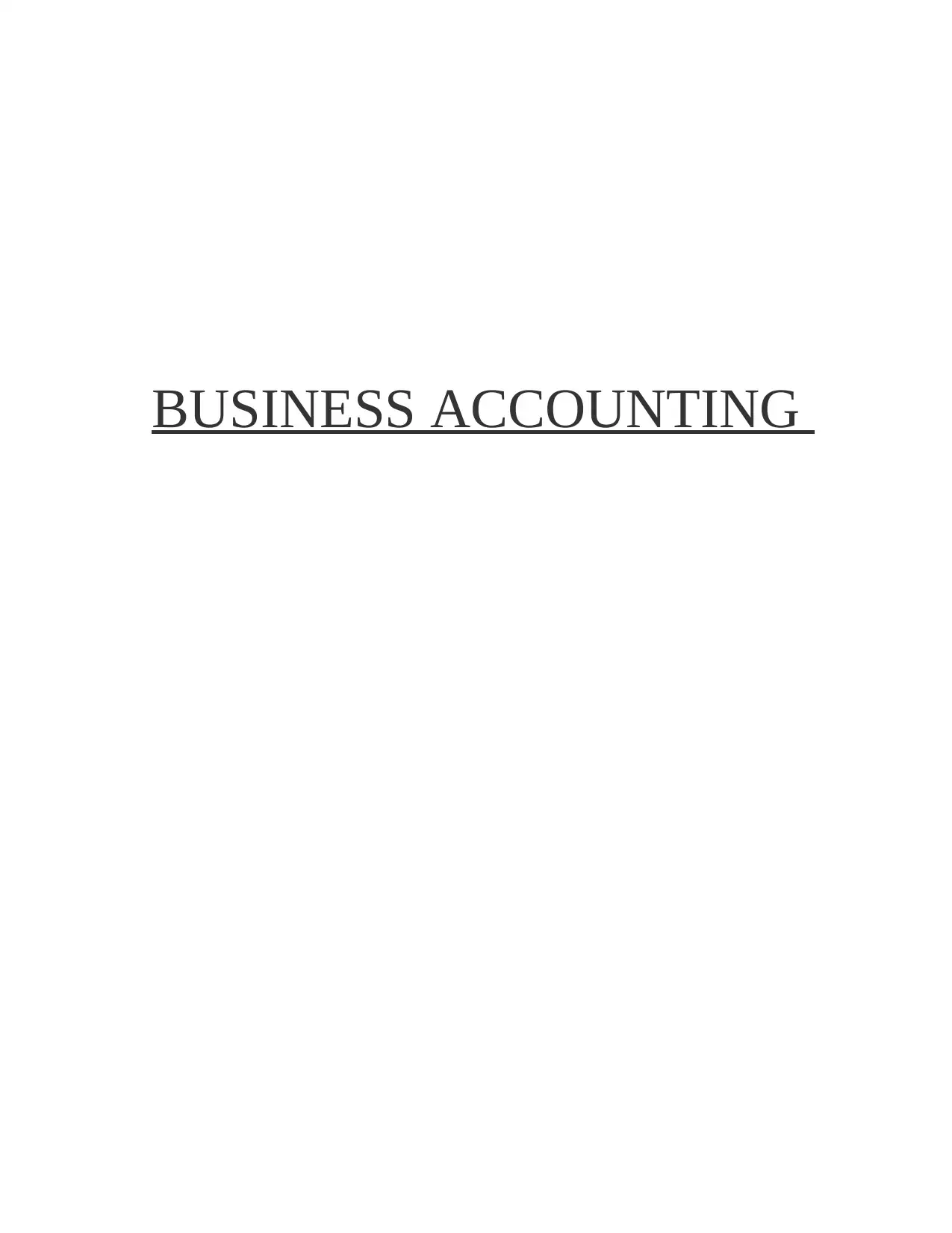
BUSINESS ACCOUNTING
Paraphrase This Document
Need a fresh take? Get an instant paraphrase of this document with our AI Paraphraser
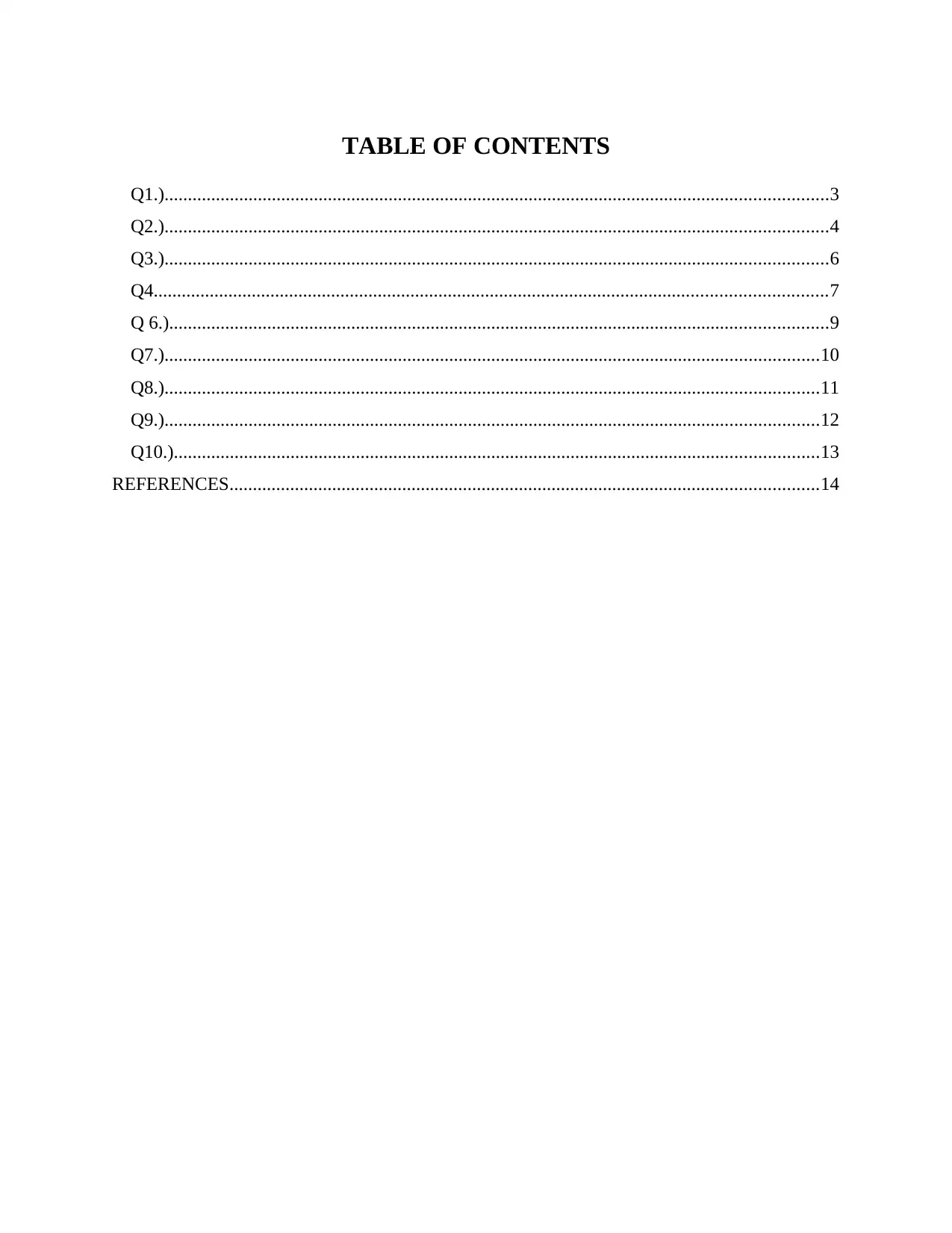
TABLE OF CONTENTS
Q1.)..............................................................................................................................................3
Q2.)..............................................................................................................................................4
Q3.)..............................................................................................................................................6
Q4................................................................................................................................................7
Q 6.).............................................................................................................................................9
Q7.)............................................................................................................................................10
Q8.)............................................................................................................................................11
Q9.)............................................................................................................................................12
Q10.)..........................................................................................................................................13
REFERENCES..............................................................................................................................14
Q1.)..............................................................................................................................................3
Q2.)..............................................................................................................................................4
Q3.)..............................................................................................................................................6
Q4................................................................................................................................................7
Q 6.).............................................................................................................................................9
Q7.)............................................................................................................................................10
Q8.)............................................................................................................................................11
Q9.)............................................................................................................................................12
Q10.)..........................................................................................................................................13
REFERENCES..............................................................................................................................14
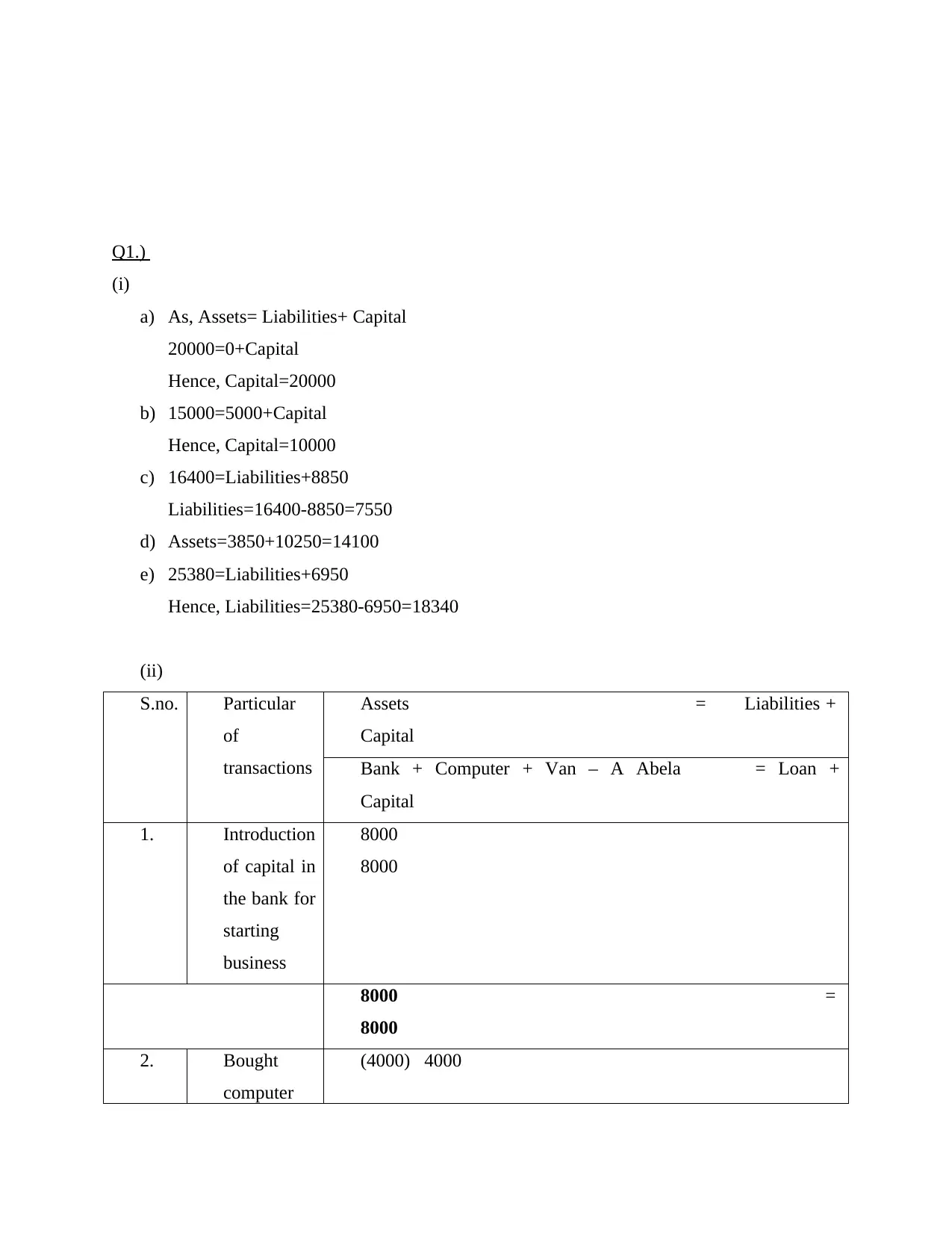
Q1.)
(i)
a) As, Assets= Liabilities+ Capital
20000=0+Capital
Hence, Capital=20000
b) 15000=5000+Capital
Hence, Capital=10000
c) 16400=Liabilities+8850
Liabilities=16400-8850=7550
d) Assets=3850+10250=14100
e) 25380=Liabilities+6950
Hence, Liabilities=25380-6950=18340
(ii)
S.no. Particular
of
transactions
Assets = Liabilities +
Capital
Bank + Computer + Van – A Abela = Loan +
Capital
1. Introduction
of capital in
the bank for
starting
business
8000
8000
8000 =
8000
2. Bought
computer
(4000) 4000
(i)
a) As, Assets= Liabilities+ Capital
20000=0+Capital
Hence, Capital=20000
b) 15000=5000+Capital
Hence, Capital=10000
c) 16400=Liabilities+8850
Liabilities=16400-8850=7550
d) Assets=3850+10250=14100
e) 25380=Liabilities+6950
Hence, Liabilities=25380-6950=18340
(ii)
S.no. Particular
of
transactions
Assets = Liabilities +
Capital
Bank + Computer + Van – A Abela = Loan +
Capital
1. Introduction
of capital in
the bank for
starting
business
8000
8000
8000 =
8000
2. Bought
computer
(4000) 4000
⊘ This is a preview!⊘
Do you want full access?
Subscribe today to unlock all pages.

Trusted by 1+ million students worldwide
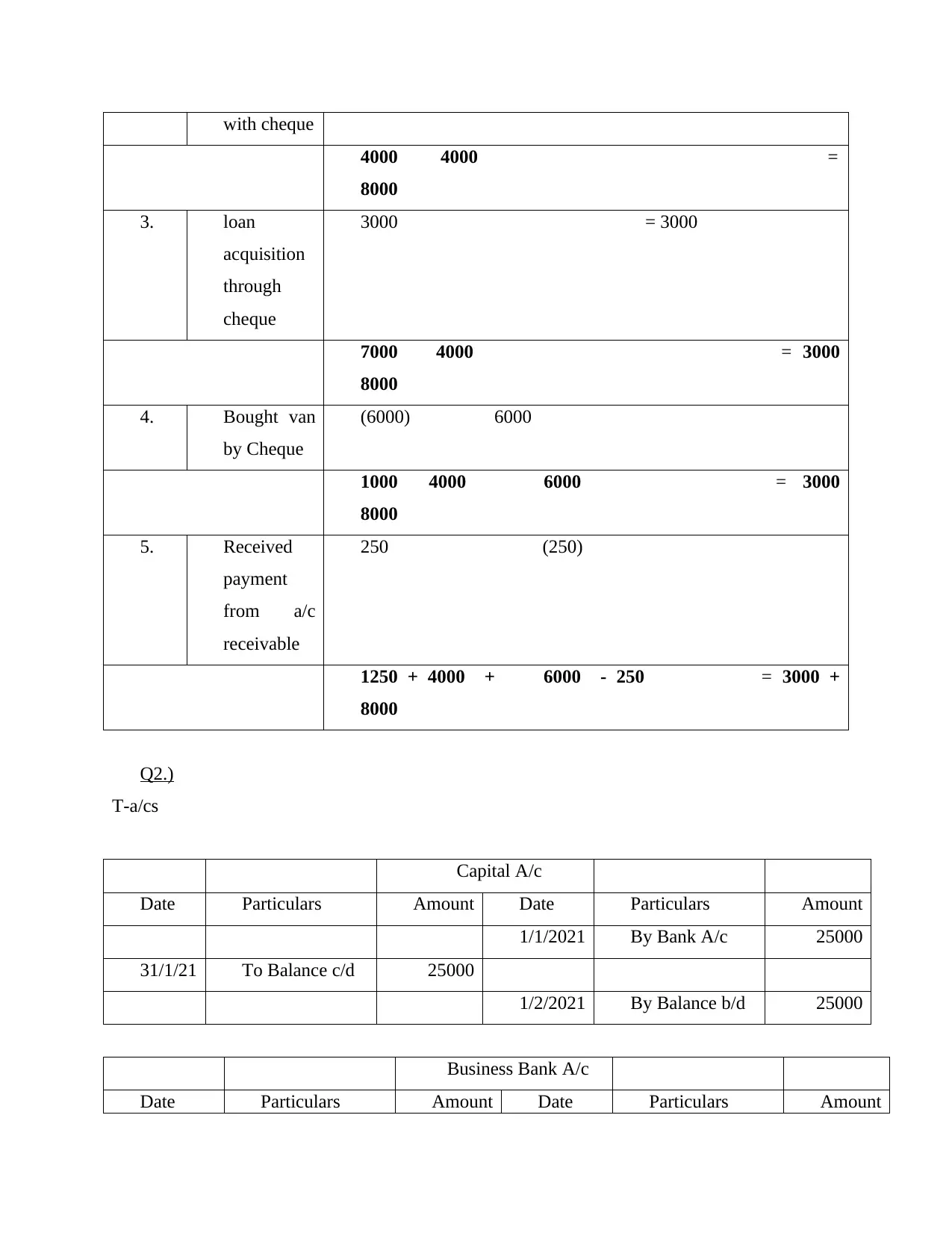
with cheque
4000 4000 =
8000
3. loan
acquisition
through
cheque
3000 = 3000
7000 4000 = 3000
8000
4. Bought van
by Cheque
(6000) 6000
1000 4000 6000 = 3000
8000
5. Received
payment
from a/c
receivable
250 (250)
1250 + 4000 + 6000 - 250 = 3000 +
8000
Q2.)
T-a/cs
Capital A/c
Date Particulars Amount Date Particulars Amount
1/1/2021 By Bank A/c 25000
31/1/21 To Balance c/d 25000
1/2/2021 By Balance b/d 25000
Business Bank A/c
Date Particulars Amount Date Particulars Amount
4000 4000 =
8000
3. loan
acquisition
through
cheque
3000 = 3000
7000 4000 = 3000
8000
4. Bought van
by Cheque
(6000) 6000
1000 4000 6000 = 3000
8000
5. Received
payment
from a/c
receivable
250 (250)
1250 + 4000 + 6000 - 250 = 3000 +
8000
Q2.)
T-a/cs
Capital A/c
Date Particulars Amount Date Particulars Amount
1/1/2021 By Bank A/c 25000
31/1/21 To Balance c/d 25000
1/2/2021 By Balance b/d 25000
Business Bank A/c
Date Particulars Amount Date Particulars Amount
Paraphrase This Document
Need a fresh take? Get an instant paraphrase of this document with our AI Paraphraser
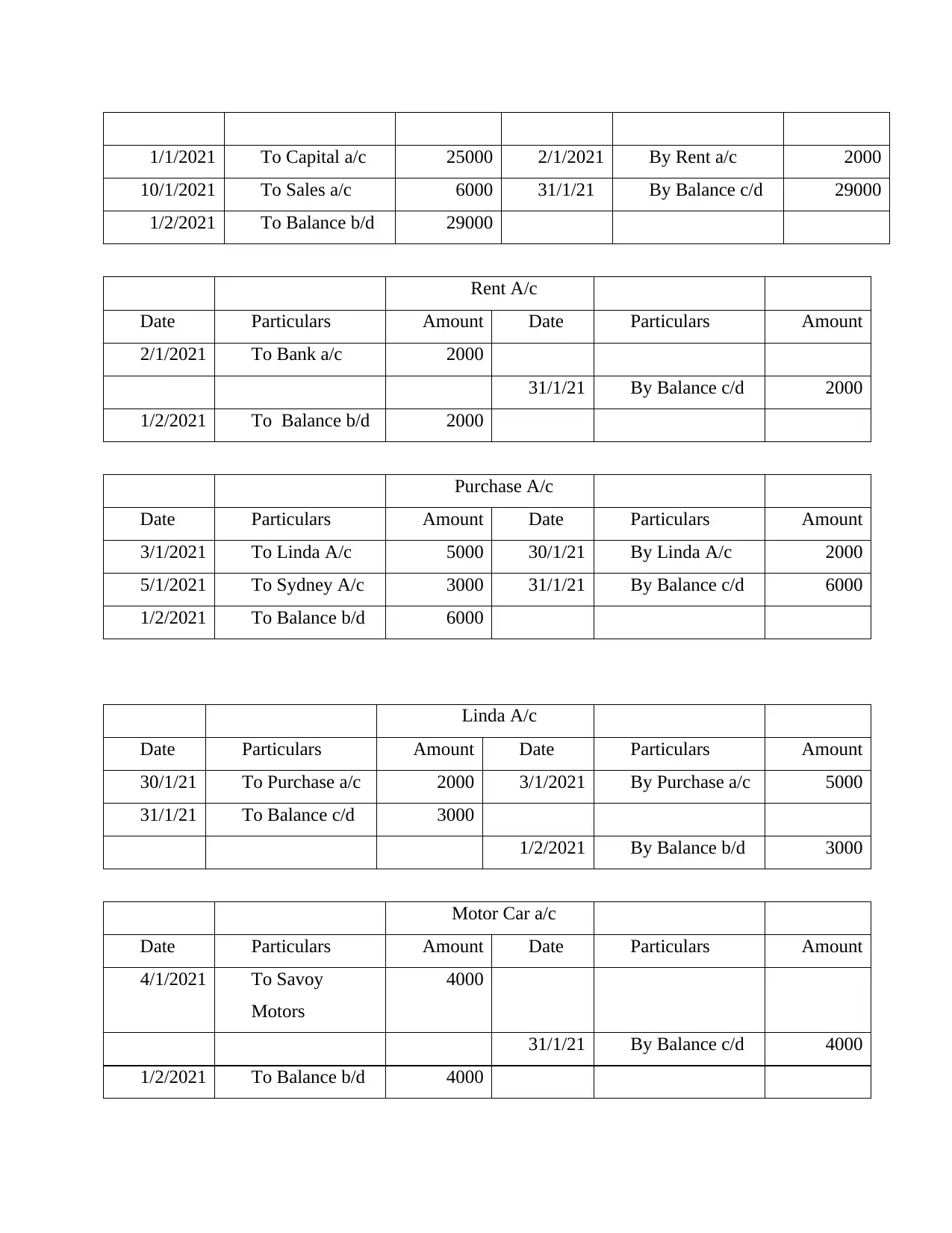
1/1/2021 To Capital a/c 25000 2/1/2021 By Rent a/c 2000
10/1/2021 To Sales a/c 6000 31/1/21 By Balance c/d 29000
1/2/2021 To Balance b/d 29000
Rent A/c
Date Particulars Amount Date Particulars Amount
2/1/2021 To Bank a/c 2000
31/1/21 By Balance c/d 2000
1/2/2021 To Balance b/d 2000
Purchase A/c
Date Particulars Amount Date Particulars Amount
3/1/2021 To Linda A/c 5000 30/1/21 By Linda A/c 2000
5/1/2021 To Sydney A/c 3000 31/1/21 By Balance c/d 6000
1/2/2021 To Balance b/d 6000
Linda A/c
Date Particulars Amount Date Particulars Amount
30/1/21 To Purchase a/c 2000 3/1/2021 By Purchase a/c 5000
31/1/21 To Balance c/d 3000
1/2/2021 By Balance b/d 3000
Motor Car a/c
Date Particulars Amount Date Particulars Amount
4/1/2021 To Savoy
Motors
4000
31/1/21 By Balance c/d 4000
1/2/2021 To Balance b/d 4000
10/1/2021 To Sales a/c 6000 31/1/21 By Balance c/d 29000
1/2/2021 To Balance b/d 29000
Rent A/c
Date Particulars Amount Date Particulars Amount
2/1/2021 To Bank a/c 2000
31/1/21 By Balance c/d 2000
1/2/2021 To Balance b/d 2000
Purchase A/c
Date Particulars Amount Date Particulars Amount
3/1/2021 To Linda A/c 5000 30/1/21 By Linda A/c 2000
5/1/2021 To Sydney A/c 3000 31/1/21 By Balance c/d 6000
1/2/2021 To Balance b/d 6000
Linda A/c
Date Particulars Amount Date Particulars Amount
30/1/21 To Purchase a/c 2000 3/1/2021 By Purchase a/c 5000
31/1/21 To Balance c/d 3000
1/2/2021 By Balance b/d 3000
Motor Car a/c
Date Particulars Amount Date Particulars Amount
4/1/2021 To Savoy
Motors
4000
31/1/21 By Balance c/d 4000
1/2/2021 To Balance b/d 4000
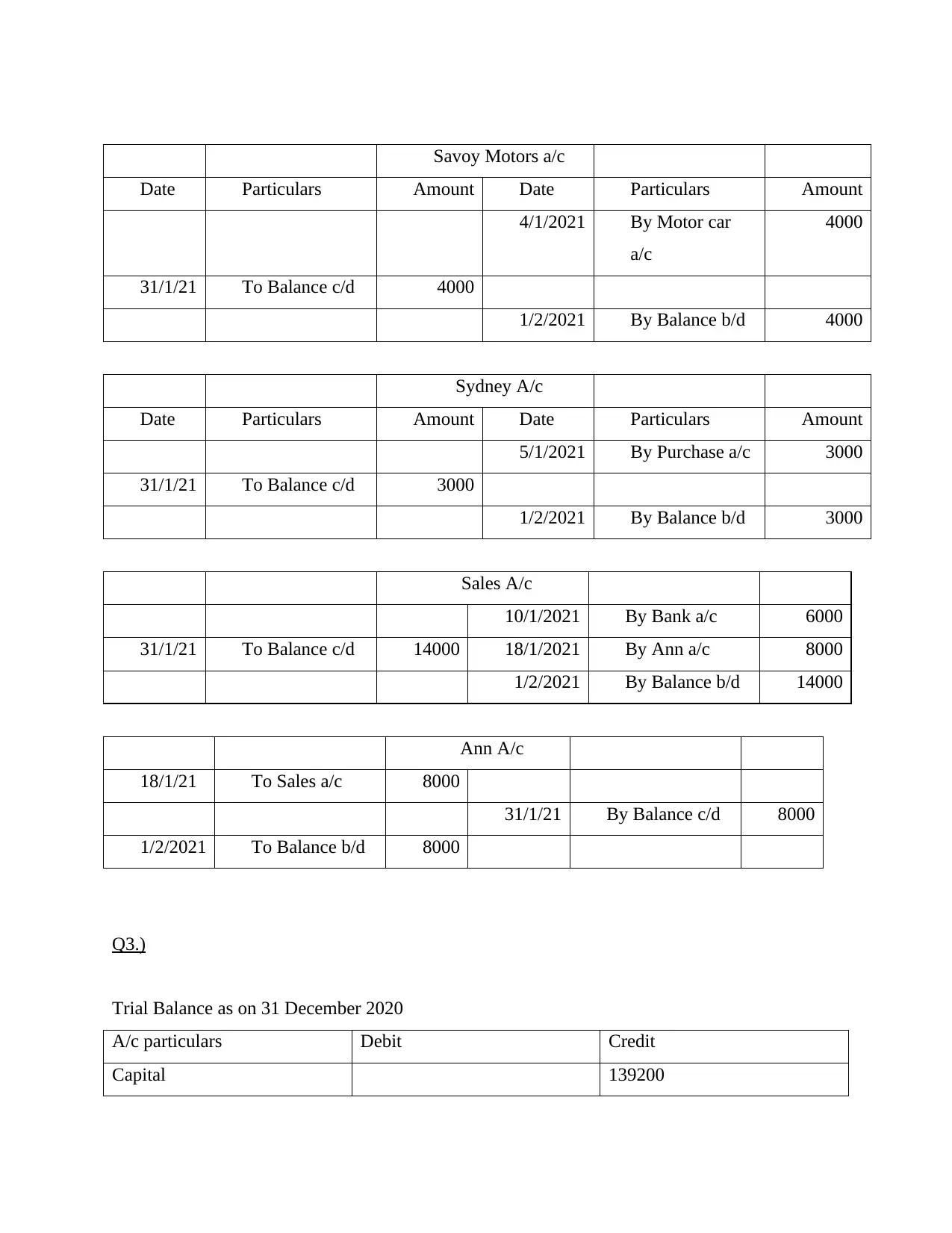
Savoy Motors a/c
Date Particulars Amount Date Particulars Amount
4/1/2021 By Motor car
a/c
4000
31/1/21 To Balance c/d 4000
1/2/2021 By Balance b/d 4000
Sydney A/c
Date Particulars Amount Date Particulars Amount
5/1/2021 By Purchase a/c 3000
31/1/21 To Balance c/d 3000
1/2/2021 By Balance b/d 3000
Sales A/c
10/1/2021 By Bank a/c 6000
31/1/21 To Balance c/d 14000 18/1/2021 By Ann a/c 8000
1/2/2021 By Balance b/d 14000
Ann A/c
18/1/21 To Sales a/c 8000
31/1/21 By Balance c/d 8000
1/2/2021 To Balance b/d 8000
Q3.)
Trial Balance as on 31 December 2020
A/c particulars Debit Credit
Capital 139200
Date Particulars Amount Date Particulars Amount
4/1/2021 By Motor car
a/c
4000
31/1/21 To Balance c/d 4000
1/2/2021 By Balance b/d 4000
Sydney A/c
Date Particulars Amount Date Particulars Amount
5/1/2021 By Purchase a/c 3000
31/1/21 To Balance c/d 3000
1/2/2021 By Balance b/d 3000
Sales A/c
10/1/2021 By Bank a/c 6000
31/1/21 To Balance c/d 14000 18/1/2021 By Ann a/c 8000
1/2/2021 By Balance b/d 14000
Ann A/c
18/1/21 To Sales a/c 8000
31/1/21 By Balance c/d 8000
1/2/2021 To Balance b/d 8000
Q3.)
Trial Balance as on 31 December 2020
A/c particulars Debit Credit
Capital 139200
⊘ This is a preview!⊘
Do you want full access?
Subscribe today to unlock all pages.

Trusted by 1+ million students worldwide
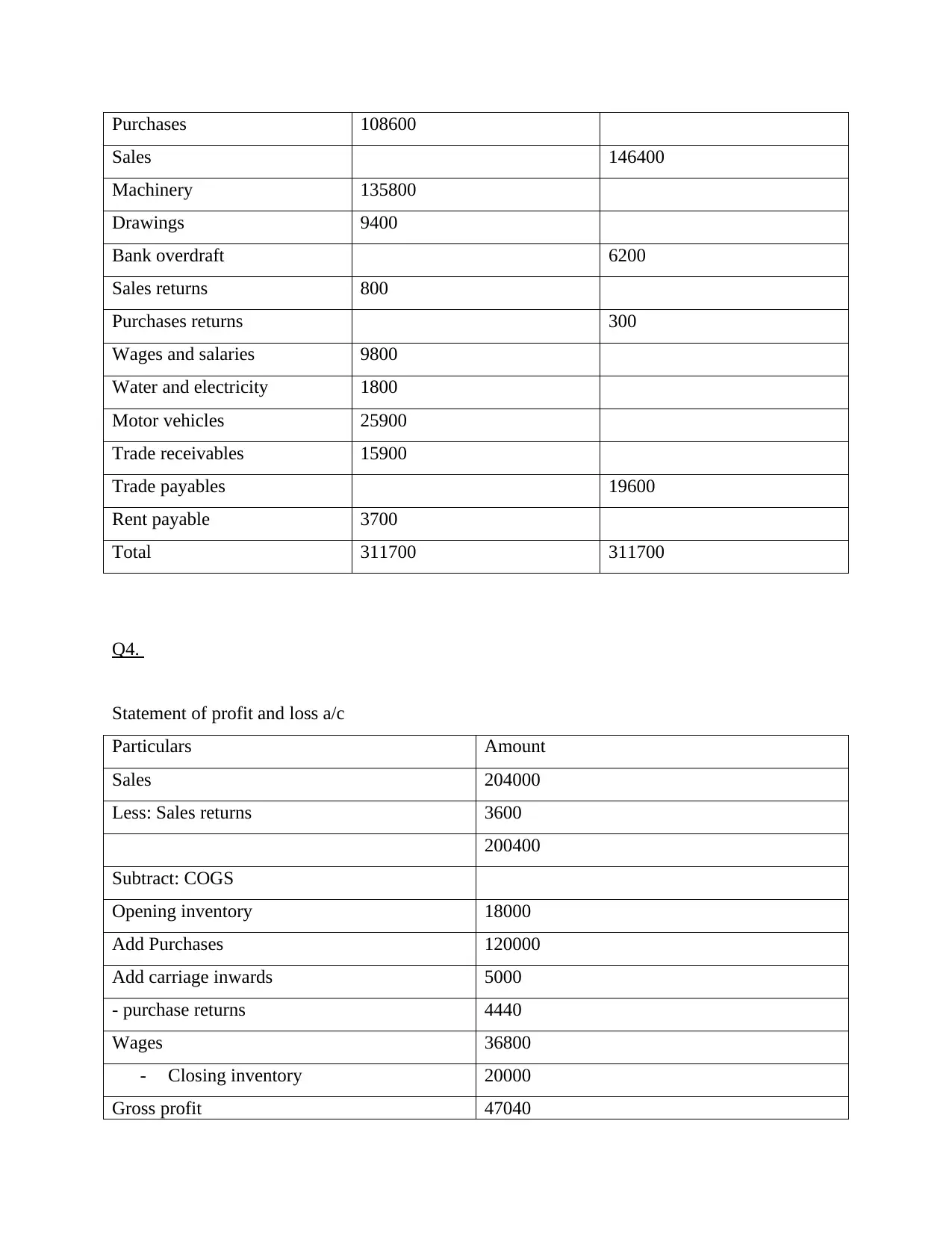
Purchases 108600
Sales 146400
Machinery 135800
Drawings 9400
Bank overdraft 6200
Sales returns 800
Purchases returns 300
Wages and salaries 9800
Water and electricity 1800
Motor vehicles 25900
Trade receivables 15900
Trade payables 19600
Rent payable 3700
Total 311700 311700
Q4.
Statement of profit and loss a/c
Particulars Amount
Sales 204000
Less: Sales returns 3600
200400
Subtract: COGS
Opening inventory 18000
Add Purchases 120000
Add carriage inwards 5000
- purchase returns 4440
Wages 36800
- Closing inventory 20000
Gross profit 47040
Sales 146400
Machinery 135800
Drawings 9400
Bank overdraft 6200
Sales returns 800
Purchases returns 300
Wages and salaries 9800
Water and electricity 1800
Motor vehicles 25900
Trade receivables 15900
Trade payables 19600
Rent payable 3700
Total 311700 311700
Q4.
Statement of profit and loss a/c
Particulars Amount
Sales 204000
Less: Sales returns 3600
200400
Subtract: COGS
Opening inventory 18000
Add Purchases 120000
Add carriage inwards 5000
- purchase returns 4440
Wages 36800
- Closing inventory 20000
Gross profit 47040
Paraphrase This Document
Need a fresh take? Get an instant paraphrase of this document with our AI Paraphraser
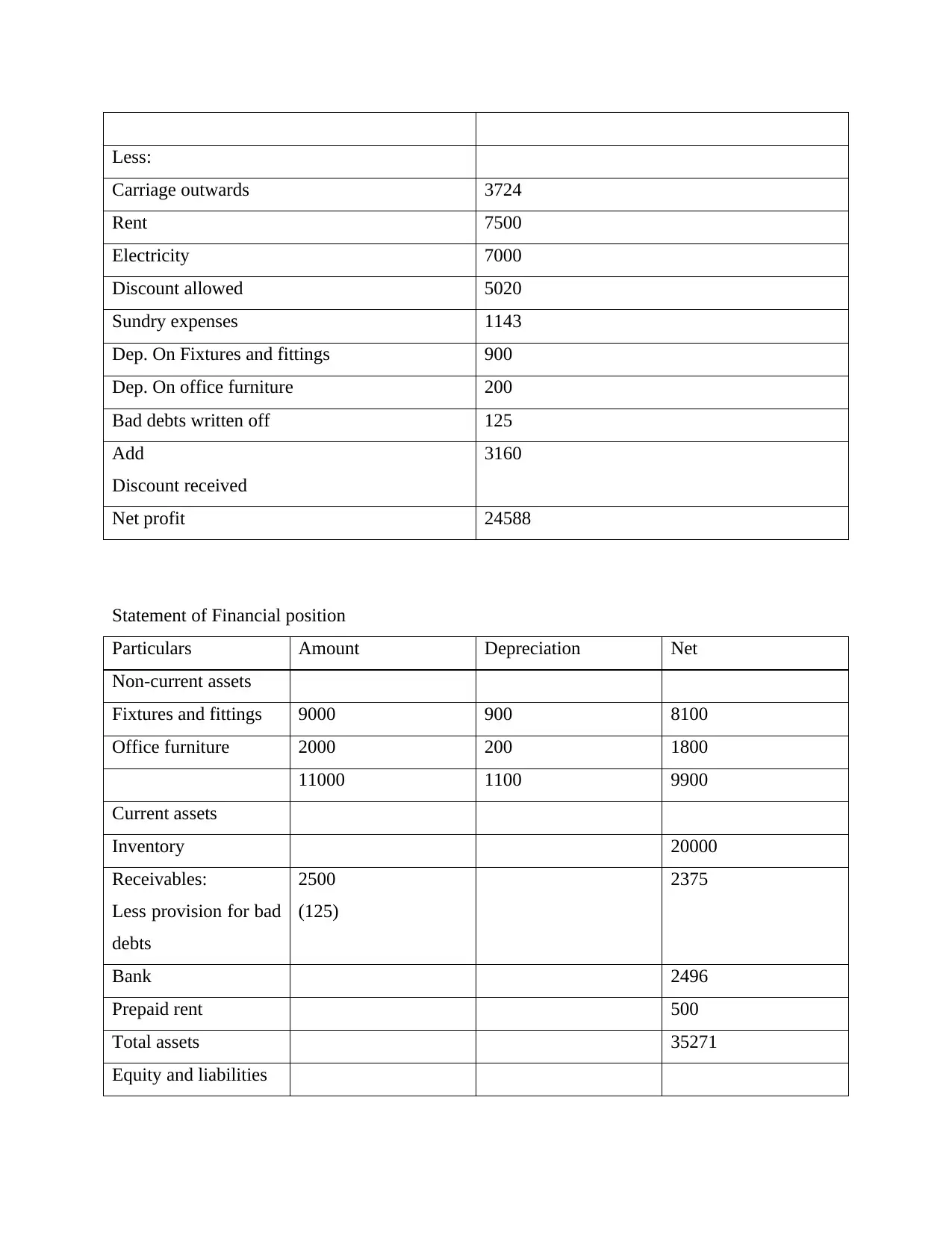
Less:
Carriage outwards 3724
Rent 7500
Electricity 7000
Discount allowed 5020
Sundry expenses 1143
Dep. On Fixtures and fittings 900
Dep. On office furniture 200
Bad debts written off 125
Add
Discount received
3160
Net profit 24588
Statement of Financial position
Particulars Amount Depreciation Net
Non-current assets
Fixtures and fittings 9000 900 8100
Office furniture 2000 200 1800
11000 1100 9900
Current assets
Inventory 20000
Receivables:
Less provision for bad
debts
2500
(125)
2375
Bank 2496
Prepaid rent 500
Total assets 35271
Equity and liabilities
Carriage outwards 3724
Rent 7500
Electricity 7000
Discount allowed 5020
Sundry expenses 1143
Dep. On Fixtures and fittings 900
Dep. On office furniture 200
Bad debts written off 125
Add
Discount received
3160
Net profit 24588
Statement of Financial position
Particulars Amount Depreciation Net
Non-current assets
Fixtures and fittings 9000 900 8100
Office furniture 2000 200 1800
11000 1100 9900
Current assets
Inventory 20000
Receivables:
Less provision for bad
debts
2500
(125)
2375
Bank 2496
Prepaid rent 500
Total assets 35271
Equity and liabilities
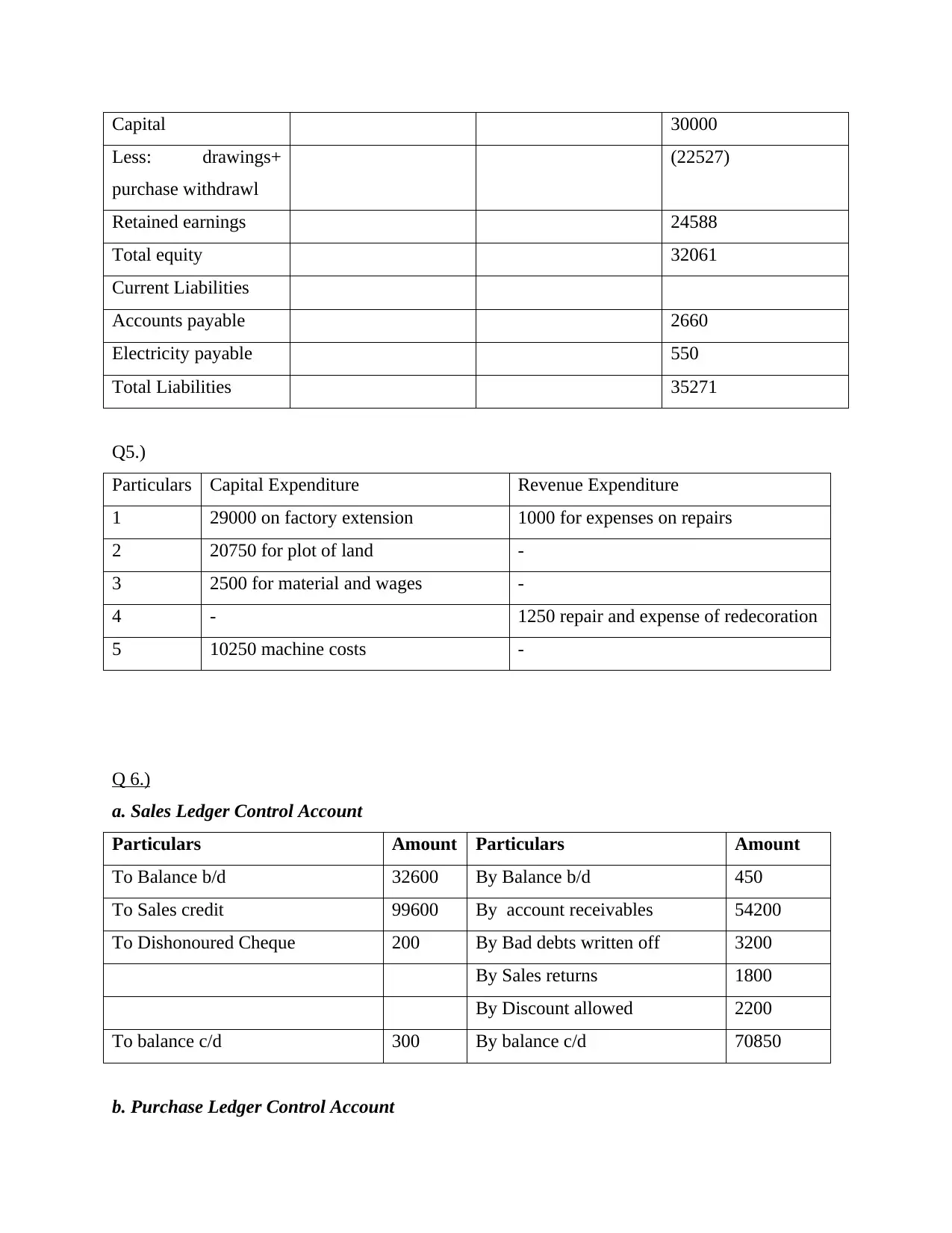
Capital 30000
Less: drawings+
purchase withdrawl
(22527)
Retained earnings 24588
Total equity 32061
Current Liabilities
Accounts payable 2660
Electricity payable 550
Total Liabilities 35271
Q5.)
Particulars Capital Expenditure Revenue Expenditure
1 29000 on factory extension 1000 for expenses on repairs
2 20750 for plot of land -
3 2500 for material and wages -
4 - 1250 repair and expense of redecoration
5 10250 machine costs -
Q 6.)
a. Sales Ledger Control Account
Particulars Amount Particulars Amount
To Balance b/d 32600 By Balance b/d 450
To Sales credit 99600 By account receivables 54200
To Dishonoured Cheque 200 By Bad debts written off 3200
By Sales returns 1800
By Discount allowed 2200
To balance c/d 300 By balance c/d 70850
b. Purchase Ledger Control Account
Less: drawings+
purchase withdrawl
(22527)
Retained earnings 24588
Total equity 32061
Current Liabilities
Accounts payable 2660
Electricity payable 550
Total Liabilities 35271
Q5.)
Particulars Capital Expenditure Revenue Expenditure
1 29000 on factory extension 1000 for expenses on repairs
2 20750 for plot of land -
3 2500 for material and wages -
4 - 1250 repair and expense of redecoration
5 10250 machine costs -
Q 6.)
a. Sales Ledger Control Account
Particulars Amount Particulars Amount
To Balance b/d 32600 By Balance b/d 450
To Sales credit 99600 By account receivables 54200
To Dishonoured Cheque 200 By Bad debts written off 3200
By Sales returns 1800
By Discount allowed 2200
To balance c/d 300 By balance c/d 70850
b. Purchase Ledger Control Account
⊘ This is a preview!⊘
Do you want full access?
Subscribe today to unlock all pages.

Trusted by 1+ million students worldwide
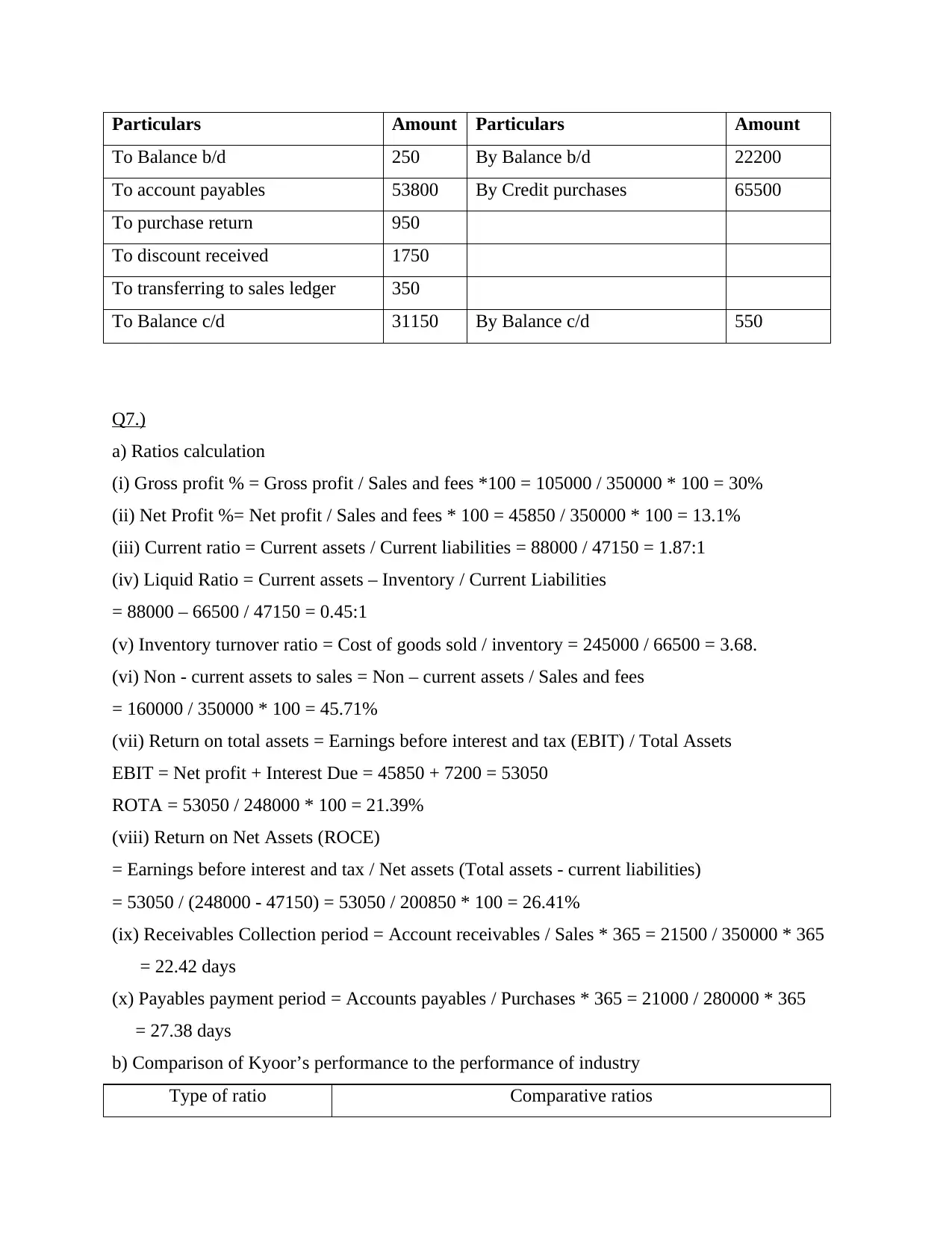
Particulars Amount Particulars Amount
To Balance b/d 250 By Balance b/d 22200
To account payables 53800 By Credit purchases 65500
To purchase return 950
To discount received 1750
To transferring to sales ledger 350
To Balance c/d 31150 By Balance c/d 550
Q7.)
a) Ratios calculation
(i) Gross profit % = Gross profit / Sales and fees *100 = 105000 / 350000 * 100 = 30%
(ii) Net Profit %= Net profit / Sales and fees * 100 = 45850 / 350000 * 100 = 13.1%
(iii) Current ratio = Current assets / Current liabilities = 88000 / 47150 = 1.87:1
(iv) Liquid Ratio = Current assets – Inventory / Current Liabilities
= 88000 – 66500 / 47150 = 0.45:1
(v) Inventory turnover ratio = Cost of goods sold / inventory = 245000 / 66500 = 3.68.
(vi) Non - current assets to sales = Non – current assets / Sales and fees
= 160000 / 350000 * 100 = 45.71%
(vii) Return on total assets = Earnings before interest and tax (EBIT) / Total Assets
EBIT = Net profit + Interest Due = 45850 + 7200 = 53050
ROTA = 53050 / 248000 * 100 = 21.39%
(viii) Return on Net Assets (ROCE)
= Earnings before interest and tax / Net assets (Total assets - current liabilities)
= 53050 / (248000 - 47150) = 53050 / 200850 * 100 = 26.41%
(ix) Receivables Collection period = Account receivables / Sales * 365 = 21500 / 350000 * 365
= 22.42 days
(x) Payables payment period = Accounts payables / Purchases * 365 = 21000 / 280000 * 365
= 27.38 days
b) Comparison of Kyoor’s performance to the performance of industry
Type of ratio Comparative ratios
To Balance b/d 250 By Balance b/d 22200
To account payables 53800 By Credit purchases 65500
To purchase return 950
To discount received 1750
To transferring to sales ledger 350
To Balance c/d 31150 By Balance c/d 550
Q7.)
a) Ratios calculation
(i) Gross profit % = Gross profit / Sales and fees *100 = 105000 / 350000 * 100 = 30%
(ii) Net Profit %= Net profit / Sales and fees * 100 = 45850 / 350000 * 100 = 13.1%
(iii) Current ratio = Current assets / Current liabilities = 88000 / 47150 = 1.87:1
(iv) Liquid Ratio = Current assets – Inventory / Current Liabilities
= 88000 – 66500 / 47150 = 0.45:1
(v) Inventory turnover ratio = Cost of goods sold / inventory = 245000 / 66500 = 3.68.
(vi) Non - current assets to sales = Non – current assets / Sales and fees
= 160000 / 350000 * 100 = 45.71%
(vii) Return on total assets = Earnings before interest and tax (EBIT) / Total Assets
EBIT = Net profit + Interest Due = 45850 + 7200 = 53050
ROTA = 53050 / 248000 * 100 = 21.39%
(viii) Return on Net Assets (ROCE)
= Earnings before interest and tax / Net assets (Total assets - current liabilities)
= 53050 / (248000 - 47150) = 53050 / 200850 * 100 = 26.41%
(ix) Receivables Collection period = Account receivables / Sales * 365 = 21500 / 350000 * 365
= 22.42 days
(x) Payables payment period = Accounts payables / Purchases * 365 = 21000 / 280000 * 365
= 27.38 days
b) Comparison of Kyoor’s performance to the performance of industry
Type of ratio Comparative ratios
Paraphrase This Document
Need a fresh take? Get an instant paraphrase of this document with our AI Paraphraser
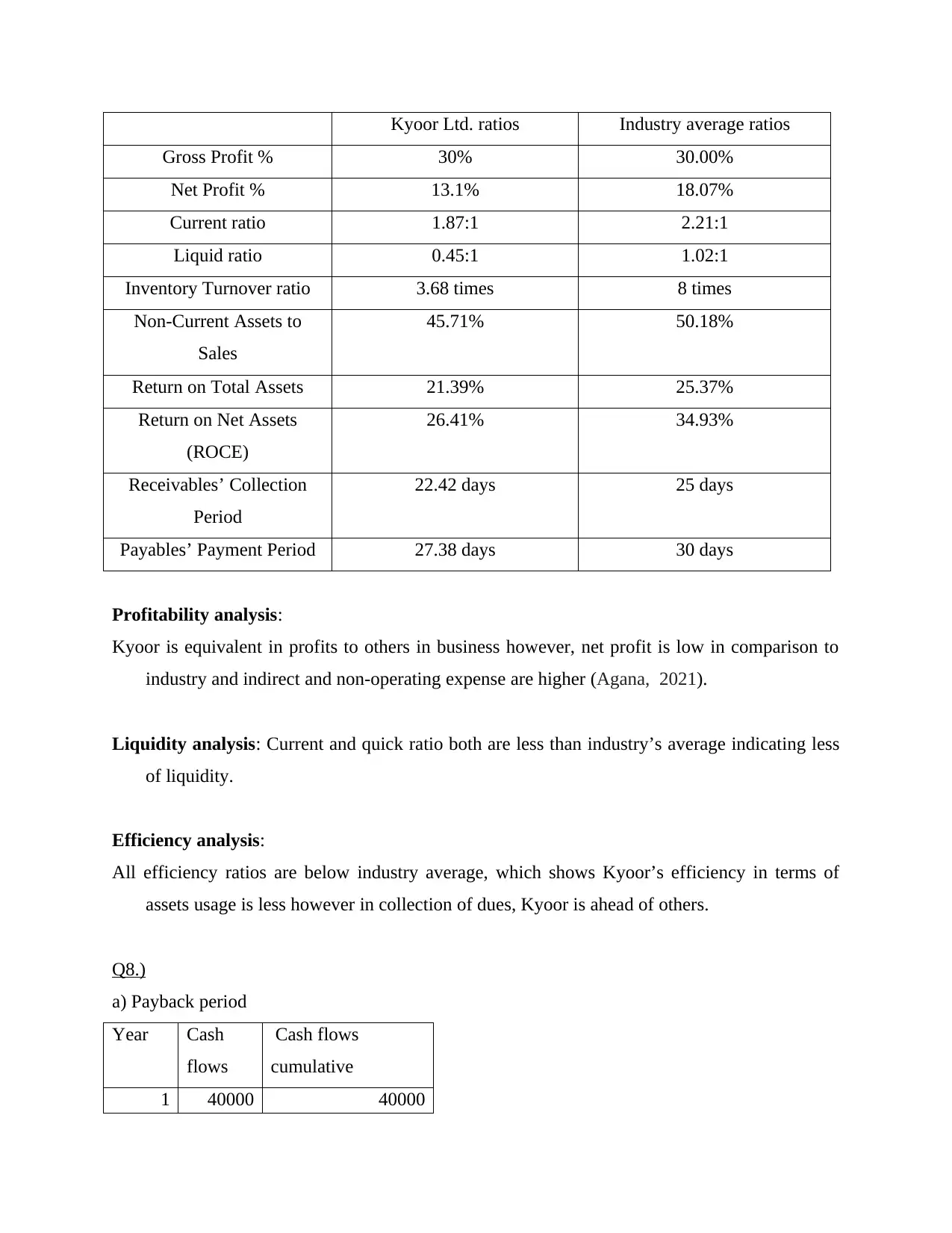
Kyoor Ltd. ratios Industry average ratios
Gross Profit % 30% 30.00%
Net Profit % 13.1% 18.07%
Current ratio 1.87:1 2.21:1
Liquid ratio 0.45:1 1.02:1
Inventory Turnover ratio 3.68 times 8 times
Non-Current Assets to
Sales
45.71% 50.18%
Return on Total Assets 21.39% 25.37%
Return on Net Assets
(ROCE)
26.41% 34.93%
Receivables’ Collection
Period
22.42 days 25 days
Payables’ Payment Period 27.38 days 30 days
Profitability analysis:
Kyoor is equivalent in profits to others in business however, net profit is low in comparison to
industry and indirect and non-operating expense are higher (Agana, 2021).
Liquidity analysis: Current and quick ratio both are less than industry’s average indicating less
of liquidity.
Efficiency analysis:
All efficiency ratios are below industry average, which shows Kyoor’s efficiency in terms of
assets usage is less however in collection of dues, Kyoor is ahead of others.
Q8.)
a) Payback period
Year Cash
flows
Cash flows
cumulative
1 40000 40000
Gross Profit % 30% 30.00%
Net Profit % 13.1% 18.07%
Current ratio 1.87:1 2.21:1
Liquid ratio 0.45:1 1.02:1
Inventory Turnover ratio 3.68 times 8 times
Non-Current Assets to
Sales
45.71% 50.18%
Return on Total Assets 21.39% 25.37%
Return on Net Assets
(ROCE)
26.41% 34.93%
Receivables’ Collection
Period
22.42 days 25 days
Payables’ Payment Period 27.38 days 30 days
Profitability analysis:
Kyoor is equivalent in profits to others in business however, net profit is low in comparison to
industry and indirect and non-operating expense are higher (Agana, 2021).
Liquidity analysis: Current and quick ratio both are less than industry’s average indicating less
of liquidity.
Efficiency analysis:
All efficiency ratios are below industry average, which shows Kyoor’s efficiency in terms of
assets usage is less however in collection of dues, Kyoor is ahead of others.
Q8.)
a) Payback period
Year Cash
flows
Cash flows
cumulative
1 40000 40000
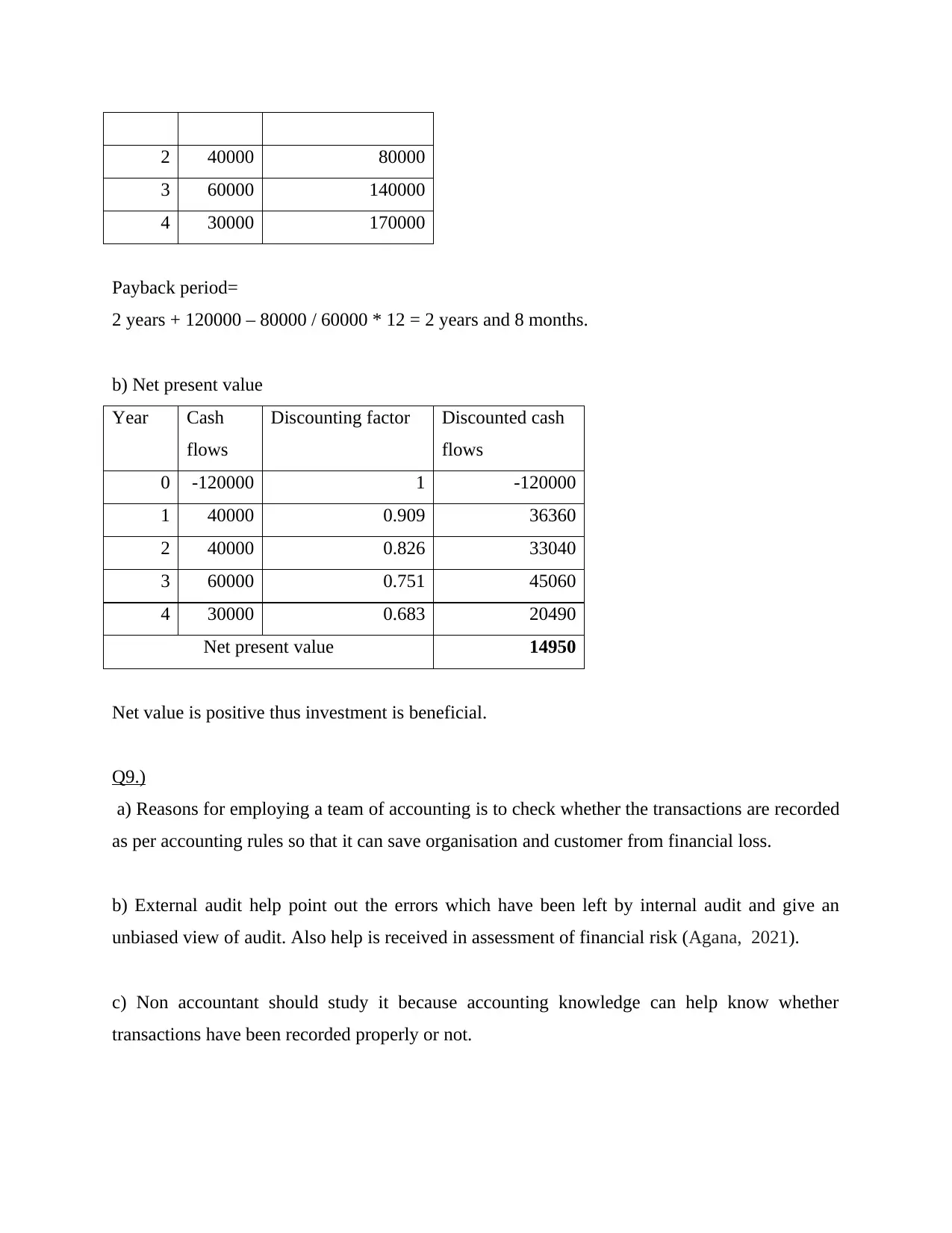
2 40000 80000
3 60000 140000
4 30000 170000
Payback period=
2 years + 120000 – 80000 / 60000 * 12 = 2 years and 8 months.
b) Net present value
Year Cash
flows
Discounting factor Discounted cash
flows
0 -120000 1 -120000
1 40000 0.909 36360
2 40000 0.826 33040
3 60000 0.751 45060
4 30000 0.683 20490
Net present value 14950
Net value is positive thus investment is beneficial.
Q9.)
a) Reasons for employing a team of accounting is to check whether the transactions are recorded
as per accounting rules so that it can save organisation and customer from financial loss.
b) External audit help point out the errors which have been left by internal audit and give an
unbiased view of audit. Also help is received in assessment of financial risk (Agana, 2021).
c) Non accountant should study it because accounting knowledge can help know whether
transactions have been recorded properly or not.
3 60000 140000
4 30000 170000
Payback period=
2 years + 120000 – 80000 / 60000 * 12 = 2 years and 8 months.
b) Net present value
Year Cash
flows
Discounting factor Discounted cash
flows
0 -120000 1 -120000
1 40000 0.909 36360
2 40000 0.826 33040
3 60000 0.751 45060
4 30000 0.683 20490
Net present value 14950
Net value is positive thus investment is beneficial.
Q9.)
a) Reasons for employing a team of accounting is to check whether the transactions are recorded
as per accounting rules so that it can save organisation and customer from financial loss.
b) External audit help point out the errors which have been left by internal audit and give an
unbiased view of audit. Also help is received in assessment of financial risk (Agana, 2021).
c) Non accountant should study it because accounting knowledge can help know whether
transactions have been recorded properly or not.
⊘ This is a preview!⊘
Do you want full access?
Subscribe today to unlock all pages.

Trusted by 1+ million students worldwide
1 out of 26
Related Documents
Your All-in-One AI-Powered Toolkit for Academic Success.
+13062052269
info@desklib.com
Available 24*7 on WhatsApp / Email
![[object Object]](/_next/static/media/star-bottom.7253800d.svg)
Unlock your academic potential
Copyright © 2020–2025 A2Z Services. All Rights Reserved. Developed and managed by ZUCOL.




